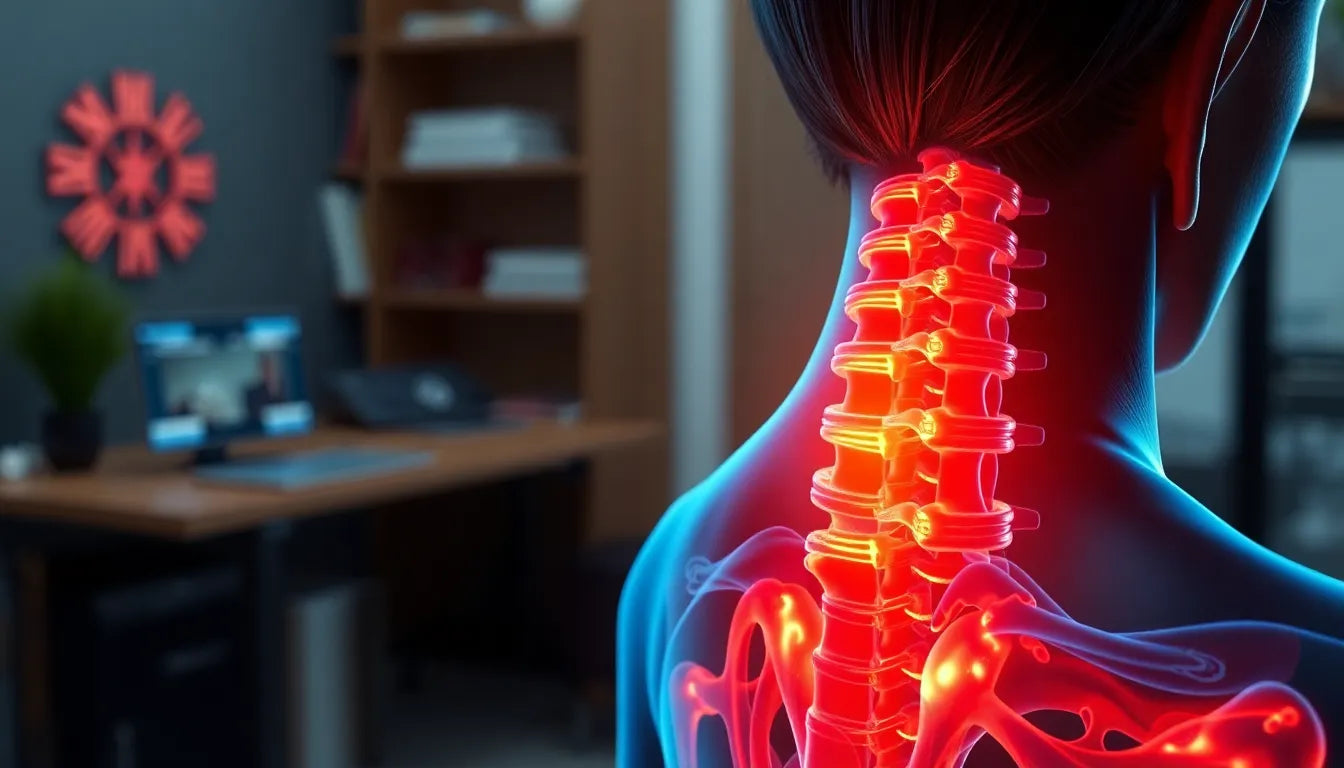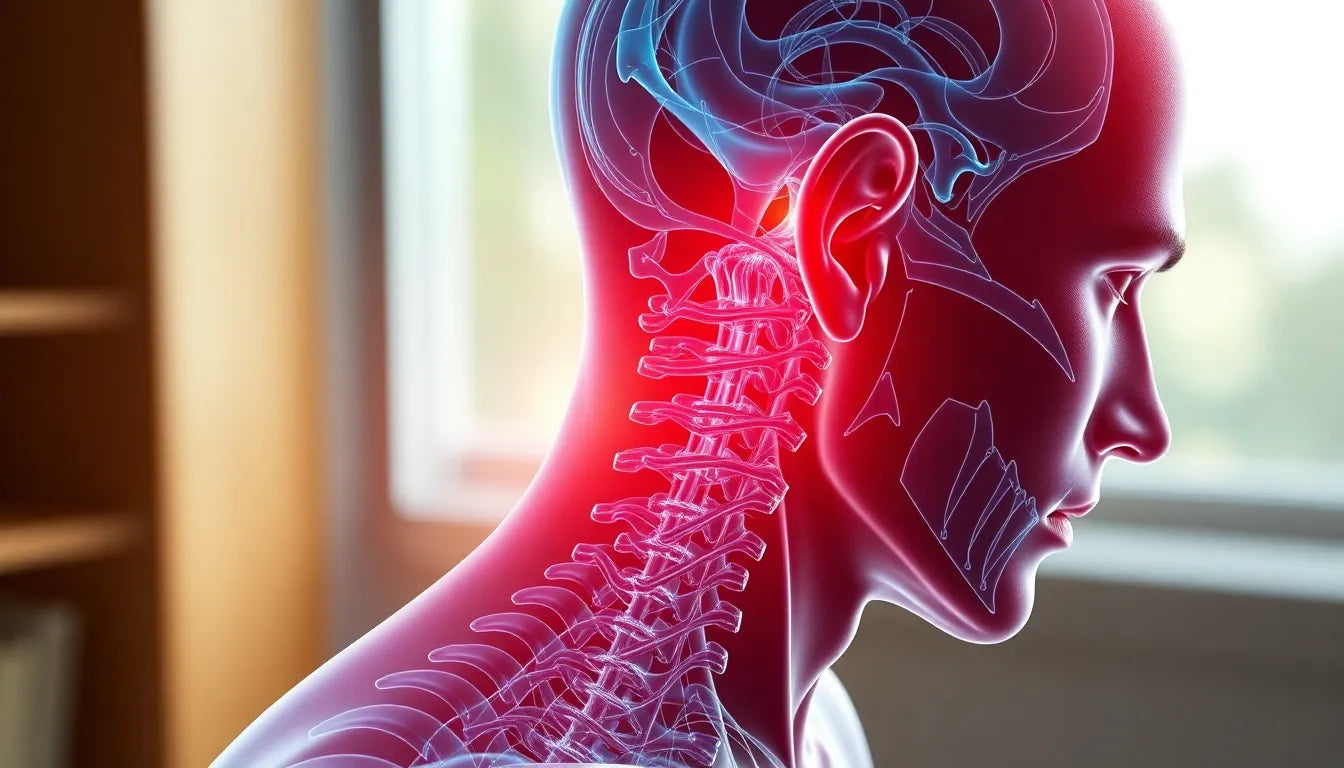The human neck is a marvel of engineering, composed of a series of vertebrae that enable a wide range of motion while supporting the head. Among these, the C5-C6 segment plays a crucial role in the cervical spine, connecting the fifth and sixth cervical vertebrae. This specific area is a common site for disc herniation, a condition that can significantly impact daily life by causing pain and reducing mobility. Understanding the intricacies of a herniated disc in the neck at C5-C6 is essential for those seeking relief from discomfort and a path back to normalcy.
Understanding the C5-C6 herniated disc
A herniated disc occurs when the soft inner gel of a spinal disc protrudes through its tougher outer layer, potentially compressing nearby nerves. At the C5-C6 level, this can lead to symptoms that are not only localized to the neck but may also radiate down into the shoulders, arms, and hands. This happens because the herniation often affects the C6 nerve root, which is responsible for sensation and muscle control in these areas. The resulting pain, numbness, or weakness can make everyday tasks challenging, from turning your head to lifting objects or even typing on a keyboard.
Common causes and risk factors
The development of a herniated disc at the C5-C6 level can be attributed to several factors. Aging is a primary cause, as the natural wear and tear on the spine can lead to disc degeneration over time. This degeneration makes the discs more susceptible to herniation. Additionally, sudden trauma, such as a car accident or a fall, can also cause a disc to herniate. Beyond these causes, certain risk factors increase the likelihood of experiencing a C5-C6 herniated disc. Poor posture, particularly when sitting for extended periods, repetitive neck movements, and even genetic predispositions can all contribute to the condition.
The importance of early intervention
Recognizing the symptoms of a herniated disc early is vital for effective treatment and preventing the condition from worsening. Initial signs may include persistent neck pain, radiating arm pain, or tingling sensations in the hands. Seeking medical advice at the onset of these symptoms can lead to a timely diagnosis and a tailored treatment plan. Early intervention often involves conservative measures such as physical therapy or medication, which can alleviate symptoms and promote healing. By addressing the issue promptly, individuals can explore a range of treatment options and potentially avoid more invasive procedures.
Recognizing symptoms of a C5-C6 herniated disc
When dealing with a herniated disc in the neck at the C5-C6 level, understanding the range of symptoms is crucial for seeking timely medical intervention. The most common symptom is neck pain, which can be quite severe and debilitating. This pain often radiates from the neck down into the arms and hands, following the path of the affected C6 nerve root. Such radiating pain can significantly interfere with daily activities, making tasks like lifting, writing, or even holding a phone uncomfortable.
In addition to pain, neurological symptoms often accompany a C5-C6 herniated disc. Individuals may experience numbness or tingling sensations, particularly in the biceps or wrist area. Muscle weakness is another prevalent symptom, which can lead to difficulties in gripping objects or performing fine motor tasks. In severe cases, although rare, individuals may encounter more alarming symptoms such as a loss of fine motor skills or even issues with bladder or bowel control, indicating a need for immediate medical attention.
Exploring non-surgical treatment options
For many experiencing a herniated disc at the C5-C6 level, non-surgical treatments provide effective relief and management of symptoms. Physical therapy is often the cornerstone of conservative treatment, focusing on exercises that enhance neck strength and flexibility. Therapists may guide patients through specific movements designed to alleviate nerve pressure and improve posture, which can be crucial in reducing pain.
Medications play a supportive role in managing the discomfort associated with a herniated disc. Nonsteroidal anti-inflammatory drugs (NSAIDs) are commonly prescribed to reduce inflammation and pain. In some cases, corticosteroids may be recommended to address more severe inflammation. These medications can help manage symptoms and enable individuals to engage more effectively in physical therapy.
Supportive devices, such as neck braces, can also be beneficial. These braces provide stability and help maintain proper posture, alleviating some of the strain on the cervical spine. For those seeking additional pain relief, injection therapies such as epidural steroid injections are available. These injections deliver medication directly to the affected area, reducing inflammation and providing temporary relief. Prolotherapy, another injection-based treatment, aims to stimulate tissue repair and regeneration, offering a potential long-term solution for some patients.
Surgical interventions for persistent pain
In cases where non-surgical treatments fail to provide adequate relief, surgical options may be considered. One common procedure is the anterior cervical discectomy and fusion (ACDF). This surgery involves removing the herniated disc and fusing the adjacent vertebrae to stabilize the spine. The primary goal of ACDF is to relieve pressure on the nerve roots, thereby alleviating pain and neurological symptoms.
For those seeking to preserve motion in the cervical spine, cervical artificial disc replacement is an alternative to traditional fusion. This procedure involves replacing the damaged disc with an artificial one, allowing for continued movement at the C5-C6 segment. Minimally invasive techniques, such as endoscopic laser repair, are also gaining popularity. These approaches offer the benefits of smaller incisions, reduced recovery times, and less postoperative pain, making them an attractive option for suitable candidates.
Ultimately, the choice between non-surgical and surgical treatments depends on the severity of symptoms, individual health factors, and personal preferences. Consulting with a healthcare professional can help determine the most appropriate path to relief, ensuring a comprehensive approach to managing a herniated disc in the neck at the C5-C6 level.
Recovery and prognosis for C5-C6 herniated disc
Understanding the recovery process for a herniated disc in the neck at the C5-C6 level is crucial for setting realistic expectations and planning for a return to normal activities. For those undergoing non-surgical treatments, recovery timelines can vary but generally range from a few weeks to several months. Many patients experience significant improvement as physical therapy and medications help reduce inflammation and strengthen the neck muscles.
For individuals who opt for surgical interventions, the recovery period tends to be longer. Procedures like anterior cervical discectomy and fusion (ACDF) or cervical artificial disc replacement typically require several weeks to months for full recovery. Patients may need to take time off work, especially if their job involves physical labor or prolonged sitting. Pain management strategies, including medications and physical therapy, are essential components of post-surgical recovery to ensure optimal healing and return of function.
Emerging trends in treatment
Advancements in medical technology have led to the development of new, less invasive treatment options for C5-C6 herniated discs. Minimally invasive surgery is becoming increasingly popular due to its benefits over traditional surgical methods. These techniques often involve smaller incisions, reduced trauma to surrounding tissues, and quicker recovery times, making them appealing to patients seeking efficient solutions with minimal downtime.
Another emerging trend is the customization of treatment plans based on individual patient needs. Healthcare providers are emphasizing the importance of personalized strategies that consider the patient’s specific symptoms, lifestyle, and overall health. This approach ensures that each patient receives the most effective treatment, whether it involves conservative management, surgical intervention, or a combination of both.
Frequently asked questions
What are the first signs of a C5-C6 herniated disc?
The initial symptoms of a C5-C6 herniated disc often include persistent neck pain and discomfort that may radiate into the shoulders, arms, and hands. Tingling or numbness in the biceps or wrist area, as well as muscle weakness, can also be early indicators of this condition.
How long does it take to recover from a herniated disc in the neck?
Recovery time can vary significantly depending on the severity of the herniation and the chosen treatment approach. Non-surgical recovery typically takes a few weeks to several months, while surgical recovery may require several months for complete healing.
When should I consider surgery for my herniated disc?
Surgery may be considered when conservative treatments fail to relieve symptoms, or if there is significant neurological impairment, such as severe muscle weakness or loss of bladder control. Consulting with a healthcare professional can help determine the appropriate timing for surgical intervention.
Can lifestyle changes help manage symptoms?
Yes, lifestyle changes can play a significant role in managing symptoms of a C5-C6 herniated disc. Maintaining good posture, engaging in regular exercise, and avoiding activities that strain the neck can help alleviate symptoms and prevent further injury.
What role do ergonomic aids play in treatment and recovery?
Ergonomic aids, such as supportive neck braces and ergonomic office equipment, can help reduce strain on the cervical spine and promote proper posture. These tools are beneficial in both the treatment and recovery phases, aiding in symptom management and enhancing the effectiveness of other therapeutic interventions.
Sources
- Deuk Spine Institute. "Minimally Invasive Laser Repair for Herniated Discs."
- Spine-health. "Cervical Herniated Disc: Surgical and Non-Surgical Options."
- Advanced Spine Center. "Understanding Symptoms of C5-C6 Herniated Disc."
- Aaron Allison Law Firm. "Legal Considerations for Work-Related Herniated Discs."
- Performance Pain. "Holistic Approaches to Herniated Disc Treatment."
- Dr. Kevin Pauza. "Innovative Discseel® Procedure for Herniated Discs."
- Alleviate Pain Clinic. "Non-Surgical Treatments for C5-C6 Herniated Discs."
- Dr. Tony Nalda. "Comprehensive Overview of C5-C6 Herniated Disc Treatments."


















